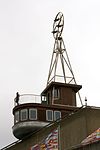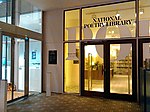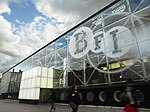Shot Tower, Lambeth
1826 establishments in EnglandBuildings and structures demolished in 1962Demolished buildings and structures in LondonFestival of BritainFormer buildings and structures in the London Borough of Lambeth ... and 3 more
Former towersShot towersTowers completed in 1826

The Shot Tower at the Lambeth Lead Works was a shot tower that stood on the South Bank of the River Thames in London, England, between Waterloo Bridge and Hungerford Bridge, on the site of what is now the Queen Elizabeth Hall. It was a prominent landmark on the river and featured in a number of paintings, including by J. M. W. Turner.
Excerpt from the Wikipedia article Shot Tower, Lambeth (License: CC BY-SA 3.0, Authors, Images).Shot Tower, Lambeth
Belvedere Road, London Lambeth (London Borough of Lambeth)
Geographical coordinates (GPS) Address Nearby Places Show on map
Geographical coordinates (GPS)
| Latitude | Longitude |
|---|---|
| N 51.506666666667 ° | E -0.11666666666667 ° |
Address
Southbank Centre
Belvedere Road
SE1 7NA London, Lambeth (London Borough of Lambeth)
England, United Kingdom
Open on Google Maps










